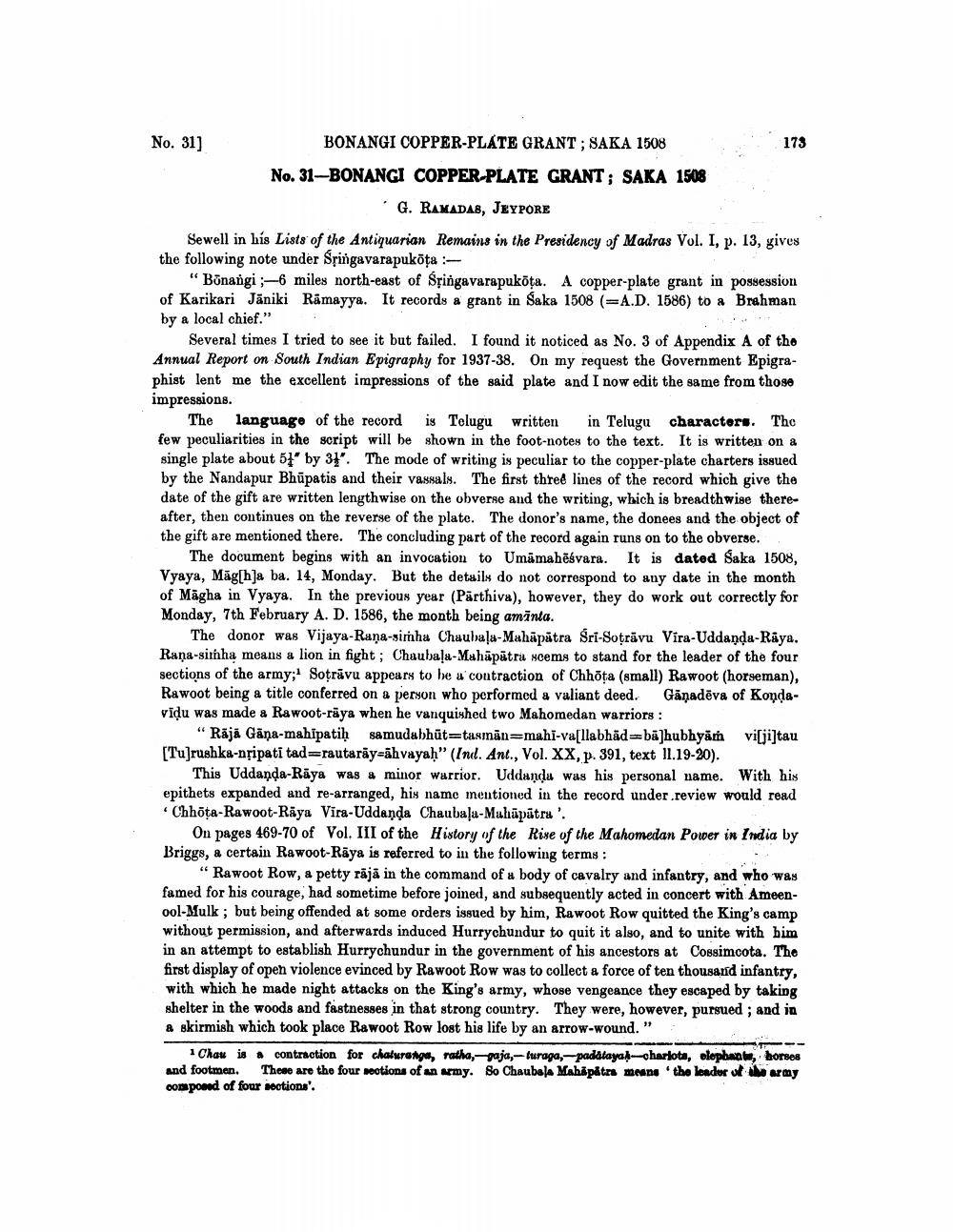________________
No. 31]
BONANGI COPPER-PLATE GRANT; SAKA 1508
No. 31-BONANGI COPPER-PLATE GRANT; SAKA 1508
173
G. RAMADAS, JEYPORE
Sewell in his Lists of the Antiquarian Remains in the Presidency of Madras Vol. I, p. 13, gives the following note under Sringavarapukota :—
"Bōnangi ;-6 miles north-east of Sringavarapukota. A copper-plate grant in possession of Karikari Jāniki Ramayya. It records a grant in Saka 1508 (=A.D. 1586) to a Brahman by a local chief."
Several times I tried to see it but failed. I found it noticed as No. 3 of Appendix A of the Annual Report on South Indian Epigraphy for 1937-38. On my request the Government Epigraphist lent me the excellent impressions of the said plate and I now edit the same from those impressions.
The language of the record is Telugu written in Telugu characters. The few peculiarities in the script will be shown in the foot-notes to the text. It is written on a single plate about 51" by 31". The mode of writing is peculiar to the copper-plate charters issued by the Nandapur Bhupatis and their vassals. The first three lines of the record which give the date of the gift are written lengthwise on the obverse and the writing, which is breadthwise thereafter, then continues on the reverse of the plate. The donor's name, the donees and the object of the gift are mentioned there. The concluding part of the record again runs on to the obverse.
The document begins with an invocation to Umamaheśvara. It is dated Saka 1508, Vyaya, Mag[h]a ba. 14, Monday. But the details do not correspond to any date in the month of Magha in Vyaya. In the previous year (Parthiva), however, they do work out correctly for Monday, 7th February A. D. 1586, the month being amanta.
The donor was Vijaya-Rana-simha Chaubala-Mahāpātra Sri-Sotrāvu Vira-Uddaṇḍa-Raya. Rana-simha means a lion in fight; Chaubala-Mahapatra scems to stand for the leader of the four sections of the army; Sotravu appears to be a contraction of Chhota (small) Rawoot (horseman), Rawoot being a title conferred on a person who performed a valiant deed. Ganadeva of Kondaviḍu was made a Rawoot-raya when he vanquished two Mahomedan warriors:
"Rājā Gaņa-mahipatiḥ samudabhüt tasman-mahi-va[llabhad-ba]hubhyam vi[ji]tau [Tu]rushka-nṛipati tad=rautaray=ahvayaḥ" (Ind. Ant., Vol. XX, p. 391, text 11.19-20).
This Uddanḍa-Raya was a minor warrior. Uddanda was his personal name. With his epithets expanded and re-arranged, his name mentioned in the record under review would read Chhota-Rawoot-Raya Vira-Uddanda Chaubala-Mahapatra'.
On pages 469-70 of Vol. III of the History of the Rise of the Mahomedan Power in India by Briggs, a certain Rawoot-Raya is referred to in the following terms:
"Rawoot Row, a petty rajā in the command of a body of cavalry and infantry, and who was famed for his courage, had sometime before joined, and subsequently acted in concert with Ameenool-Mulk; but being offended at some orders issued by him, Rawoot Row quitted the King's camp without permission, and afterwards induced Hurrychundur to quit it also, and to unite with him in an attempt to establish Hurrychundur in the government of his ancestors at Cossimcota. The first display of open violence evinced by Rawoot Row was to collect a force of ten thousand infantry, with which he made night attacks on the King's army, whose vengeance they escaped by taking shelter in the woods and fastnesses in that strong country. They were, however, pursued; and in a skirmish which took place Rawoot Row lost his life by an arrow-wound."
Chau is a contraction for chaturanga, ratha,-gaja,-turaga,-padatayaḥ-charlots, elephants, horses and footmen. These are the four sections of an army. So Chaubala Mahapatra means the leader of the army composed of four sections".




